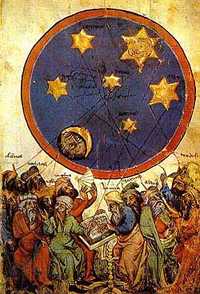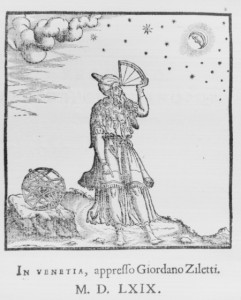The signs of the zodiac are a belief that certain time periods, for example the 12 months of the year, or the cycles of the moon hold special value and can be used to predict the fortunes and life of the person born under the sign. Astrologists are people considered to have a gift for reading the signs and usually study for many years to understand the meanings behind the zodiac.
In ancient times before humans settled in villages and before the invention of writing the ability to predict the passage of the sun, moon, and other sky objects was particularly useful because memorizing the positions of the stars and planets in relation to the moon was the only way ancient people had of predicting the changing of seasons, determining where they were, and appeasing the gods who were known to be fickle and constantly warring against each other and occasionally against people as well.

In modern times we see the stars and planets as celestial objects with mass and their own orbits rather than as gods, but we shouldn’t discount the value of the ancient’s observations since it was they who produced the first calendars and calculations we still use today for tracking the movement of celestial objects. Their need to predict other portentious sky events such as comets helped lay the groundwork for modern astronomy.
In the earliest known times, around 6000-7000 years ago, Mesopotamian priests in the Sumer valley would track the movements of the sun, the moon, and Venus in relation to the stars as they appeared during the year. The sun, moon, and Venus were considered gods, and their path thru the sky would be used to indicate the changing seasons, and the summer and winter solstices. The patterns in the stars weren’t considered terribly important, although events such as shooting stars were either a sign of good luck or of impending doom depending on the reading of the priest at the time.

Indian astronomers in Vedic times used the passage of the sun to understand the changing of the seasons and identified the sun with Vishnu who was said to have three aspects, the ram, the lion, and the bull, coincidentally, symbols that made their way into modern astrology from the shifting political landscape of the Near East and India under Alexander the Great.
Ancient Egyptians were perhaps the first to identify portents relating to the individual in the stars and passage of the sun and moon and other celestial objects. Records indicate that as early as 2750 BC astrologers were writing horoscopes for important people in Egyptian society although these were not based on signs of the zodiac so aren’t direct ancestors of today’s horoscope readings.
Around 1300BC or perhaps a little earlier, Assyrian people in the Near East started to gain power and influence in the region and conquered or absorbed most of their neighbors and noticed the further away from home they traveled that the stars were always the same, perhaps a little higher or lower in the sky but essentially the same, leading them to develop constellations, an act that made for more accurate calendars. They borrowed symbols for their constellations from their own religion and the folklore of conquered people.
Originally the Assyrians had eighteen constellations but by the time of Alexander the Great these had reduced to just twelve. Greek warriors brought the knowledge of the Babylonian constellations back to ancient Greece whose priests found them to be a wonderful addition to their existing knowledge of the gods. The Babylonian zodiac had twelve constellations, Aries, Pleiades, Gemini, Praesepe, Leo, Spica, Libra, Scorpio, Sagittarius, Capricornus, Aquarius, and Pisces.
Greek astrologers changed the names of Pleiades, Praesepe, Spica, and Capricornus to Cancer, Taurus, Virgo, and Capricorn and so they have remained to this day. Each constellation was assigned to a god or hero and special significance attached to each zodiac sign based on the strengths or magic of its namesake.
The Greeks placed enormous importance on the day of one’s birth, and with the new constellations it was now possible to determine the strengths of the person at birth and perhaps prepare their parents and then it was hoped the individual himself for the challenges ahead by knowing which god or hero would be their protector. The Greeks came to believe that a person’s life was pre-ordained and that every major event could be predicted thru knowledge of horoscopes.

Modern astrology is mostly erived from the writings of the Greek astronomer and mathmetician Ptolomy, no relation that we know of to the Egyptian pharoahs of the same name although he was head librarian at Alexandria’s great library and so had access to all of the civilized world’s writings on the passage of the celestial bodies. His four volume work on astrology, the Tetrabiblos, described everything about astrology known to the ancient Greeks.
Subsequent Roman and Arabic knowledge of astrology is directly descended from Ptolemy’s writings. The Romans were less interested in astrology than the Greeks and medieval people, tending to disagree that a person’s life was preordained and instead preferring to place their fate in the hands of the gods and their own actions.
After the fall of the Roman Empire medieval society reverted to local folklore and astrology was lost to western society until the Arab world rediscovered Ptolomy’s writings around the turn of the first millennium. Astrology was largely unchanged from Greek times into the renaissance period despite disappearing from daily use for several hundred years. Protestant and puritan Christians rejected astrology as un-Christian, but in Catholic parts of Europe the signs of the zodiac and horoscopes were often identified with the power of the saints.
In the 20th century astrology found new converts in the western world particularly the US where people were seeking more meaning to life as the traditional community based around a local church started to disappear. Astrology was easily adopted by people investigating other faiths such as buddhism, wicca, kaballah and other esoteric traditions. Many tarot readers found great synergy with astrology and have helped to keep the ancient art of astrology alive into the 21st century.

Comments are closed